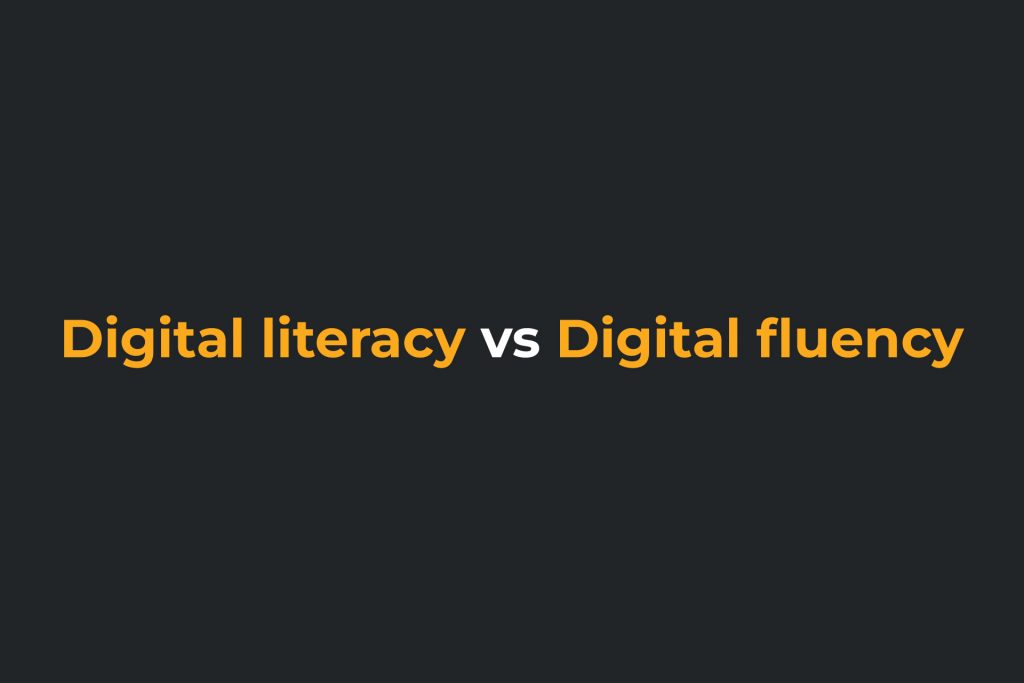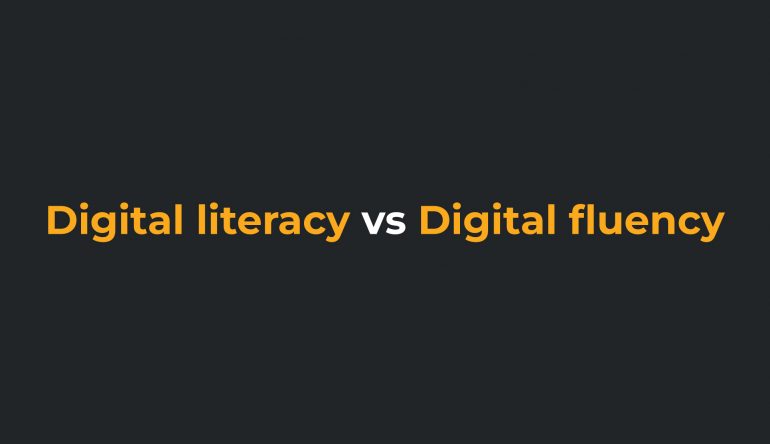In the age of digital transformation, it’s increasingly important for everyone to have a certain level of software literacy and proficiency.
Whether you’re already adept with technology or are just beginning to explore its potential, understanding the distinction between digital literacy and digital fluency is critical in order to harness all what current and emerging technologies have to offer.
Due to that, in this blog post, we will explore what are digital literacy and digital fluency and the differences between them.
So, keep reading to find out what they are and what the experts said about them!

What is digital literacy?
Simply put, digital literacy is the ability to use technology and digital devices, such as computers and smartphones, to access, understand, create, and communicate information.
It refers to the knowledge and skills required to effectively and ethically use digital technologies for personal and professional purposes.
With digital literacy, individuals can tap into a world of opportunities – from crafting an engaging word document to navigating the ever-changing online landscape.
In addition, It is essential for effective communication and understanding technology’s impact on society today and how each person should responsibly use it with proper ethical considerations in mind.

Back in 2009, Duke and Ward stated that the way we communicate has changed in the 21st century and now requires digital literacy and fluency.
They emphasized that both educators and students must be proficient in using technology, discovering and evaluating information, in order to effectively teach and learn in today’s digitally connected world. This is a necessary step to reach the teaching and learning goals of the 21st century.
Moreover, the NMC Horizont report from 2014 stated that digital literacy is about thinking, not just using tools. The skills and standards that focus on specific tools and platforms are not permanent and can quickly become outdated.
However, despite the agreement on the significance of digital media literacy, there is a lack of training for teachers and faculty on the necessary skills and techniques. In teacher education, such training is rare, and in the preparation of faculty, it is non-existent.
Next NMC Horizon Report [2018] reflects that digital literacy is still a major challenge facing educators today, emphasizing the need for them to remain abreast of emerging technology.
So, technology has revolutionized our lives, introducing us to amazing new possibilities while also exposing us to the burden of data overload.
This leads to the fact that digital literacy is now a fundamental skill for all ages to thrive and remain competitive in this increasingly tech-driven society.
What is digital fluency?
On the other hand, digital fluency is far more than a basic understanding of how to operate digital devices and technology.
Simply, it reflects an ability to harness the power of digital tools in order to enhance everyday life.
A digitally fluent individual has not only technical proficiency but also critical thinking skills, creativity, collaboration capabilities, and much more.

They can use their knowledge of technology in flexible ways that are tailored for problem-solving or decision-making across various settings (both personal and professional) helping them advance productivity while maintaining overall quality.
Two decades ago, Resnick (2002) emphasized the importance of fluency in using multimedia in education.
He believed that in the future, digital fluency would be a requirement for getting a job, being actively involved in society, and continuously learning throughout one’s life.
According to Resnick, this shift away from just focusing on information in education is necessary for success in the digital age.
The online Oxford English Dictionary (2013) defines fluency as:
(a) The quality or condition of flowing smoothly
(b) A smooth and easy flow, especially in regard to speech
(c) The lack of rigidity and ease
(d) The readiness of expression, characterized by the flow of words.
This definition describes a level of ease in using language to communicate.
The difference between digital literacy and digital fluency
Digital literacy and digital fluency are related, but distinct concepts.
Jennifer Sparrow, the Senior Director of Teaching and Learning at Penn State University, explained the difference between digital fluency and digital literacy.
She compared it to learning a foreign language. A person who is literate in a language can read, speak, and listen, while a fluent person can create something in that language.
Similarly, digital literacy is understanding how to use technology tools, while digital fluency is the ability to create something new using those tools.
So, digital literacy is the foundation for digital fluency.
It requires an understanding and proficiency in basic technical skills to use computer systems, emails, websites, and other online applications.

On the other hand, digital fluency goes a step further – it involves an elevated aptitude in using technology with problem-solving capabilities by constructing constructive opinions regarding evolving developments within our increasingly tech-driven world.
With this skill comes not only knowledge of how to operate devices but also critical thinking along with creativity that helps create useful solutions while collaborating virtually or otherwise effectively communicating information.
The National Research Council (NRC) in their publication “Being Fluent with Information Technology” (1999) preferred the use of the word “fluency” over “literacy” because of the rapid pace of technological change.
According to the NRC, the goal of literacy is too limited in a rapidly changing environment as it lacks the ability to adapt to new changes.
As technology rapidly evolves, existing skills become outdated and there is no clear path to acquiring new ones. That’s why fluency is seen as a more appropriate term in the context of technology and information.

In the end, Miller and Bartlett (2012) agreed that the terms “literacy” and “fluency” are not interchangeable but are closely related.
They use the term “fluency” to describe the combination of new skills needed for critical engagement with online information. These skills include traditional critical thinking abilities, internet-specific technical knowledge, and ICT-specific competencies.
According to Miller and Bartlett, these skills are interrelated and collectively referred to as “digital fluency.”
Importance of digital literacy and digital fluency
First, digital literacy is one of the crucial life skills, particularly for younger generations growing up in an increasingly digitalized world.
Teaching kids to use technology responsibly and understand the potential implications of their actions empowers them as they navigate modern communication platforms.

Additionally, investing in teaching children how to embrace this integral part of our culture today builds healthier digital experiences tomorrow.
On the other hand, digital fluency has become increasingly important in all aspects of our lives.
Whether for personal or professional purposes, being able to use digital technology effectively is no longer seen as a bonus skill, but rather a necessity for success.
From seamlessly navigating websites and social media platforms to utilizing specialized software applications – engaging the digital world requires skill and savvy.
Conclusion
As we can see, digital literacy and digital fluency are two important but distinct skill sets.
Digital literacy refers to the ability to use technology to perform basic tasks while digital fluency is the ability to use technology for more complex applications.
While both are important in today’s world, businesses should focus on ensuring their employees have the skills needed to be digitally fluent as this will give them a competitive advantage.
Finally, digital literacy and digital fluency are crucial for success in the digital age, so they should be developed together to ensure a well-rounded digital education.
Related: All about education website design.
References
1. Duke S.T. & Ward, J.D. 2009. Preparing information literate teachers: A meta-synthesis. Library & Information Science Research 31 (2009) 247–256
2. Jennifer Sparrow, Senior Director of Teaching and Learning at Penn State University: https://er.educause.edu/articles/2018/3/digital-fluency-preparing-students-to-create-big-bold-problems
3. Miller, C., & Bartlett, J. (2012) ‘Digital fluency’: Towards young people’s critical use of the
internet. Journal of Information Literacy 6(2), 35-55.
4. National Research Council (NRC), (1999). Being Fluent with Information Technology.
Washington, DC: National Academy Press. Retrieved from
http://www.nap.edu/openbook.php?record_id=6482&page=2
5. Oxford English Dictionary (2013). Fluency. Oxford University Press. Retrieved from:
http://www.oed.com/view/Entry/72066?redirectedFrom=fluency#eid
6. Resnick, M. (2002). Rethinking Learning in the Digital Age. In G. Kirkman
(Ed.), The global information technology report: Readiness for the networked word. Oxford, UK: Oxford University Press.





